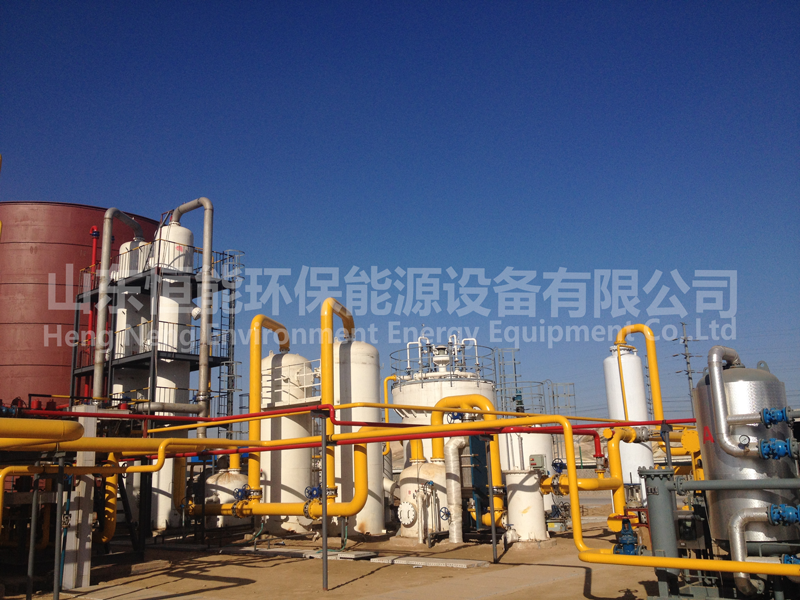歡迎進入山東恒能環(huán)保能源設(shè)備有限公司
歡迎進入山東恒能環(huán)保能源設(shè)備有限公司
脫硫劑狀態(tài)
Status of desulfurizer
干法脫硫:使用固體脫硫劑,如常見的氧化鐵、活性炭等。這些固體脫硫劑裝填在脫硫塔內(nèi),以固態(tài)形式與沼氣中的硫化氫發(fā)生反應(yīng)。
Dry desulfurization: using solid desulfurizers such as common iron oxide, activated carbon, etc. These solid desulfurizers are loaded into the desulfurization tower and react with hydrogen sulfide in the biogas in solid form.
濕法脫硫:采用液體脫硫劑,根據(jù)不同原理,有化學(xué)吸收法的堿性溶液(如 ADA 法中的蒽醌二磺酸鈉堿性溶液),還有物理吸收法的低溫甲醇等。液體脫硫劑在設(shè)備內(nèi)循環(huán)流動,與沼氣接觸吸收硫化氫。
Wet desulfurization: using liquid desulfurizer, according to different principles, there are alkaline solutions for chemical absorption method (such as alkaline solution of sodium anthraquinone disulfonate in ADA method), as well as low-temperature methanol for physical absorption method. The liquid desulfurizer circulates and flows inside the equipment, coming into contact with biogas to absorb hydrogen sulfide.
反應(yīng)原理
Principle
干法脫硫:主要基于化學(xué)反應(yīng),固體脫硫劑中的成分與硫化氫進行反應(yīng)。以氧化鐵脫硫劑為例,氫氧化鐵與硫化氫反應(yīng)生成硫化鐵和水,通過這種化學(xué)反應(yīng)將硫化氫從沼氣中脫除。
Dry desulfurization: mainly based on chemical reactions, the components in solid desulfurizers react with hydrogen sulfide. Taking iron oxide desulfurizer as an example, iron hydroxide reacts with hydrogen sulfide to produce iron sulfide and water, and through this chemical reaction, hydrogen sulfide is removed from biogas.
濕法脫硫:化學(xué)吸收法是利用堿性溶液與硫化氫發(fā)生化學(xué)反應(yīng),生成硫氫化鈉等中間產(chǎn)物,再通過氧化轉(zhuǎn)化為單質(zhì)硫;物理吸收法則是依據(jù)脫硫劑在特定條件下(如低溫甲醇洗法中甲醇在低溫下)對硫化氫有較高溶解度的物理特性,將硫化氫溶解在液體脫硫劑中從而實現(xiàn)分離。
Wet desulfurization: Chemical absorption method uses alkaline solution to react with hydrogen sulfide to produce intermediate products such as sodium hydrosulfide, which are then converted into elemental sulfur through oxidation; The physical absorption law is based on the physical properties of desulfurizers that have high solubility for hydrogen sulfide under specific conditions (such as methanol at low temperature in low-temperature methanol washing method), and dissolve hydrogen sulfide in liquid desulfurizers to achieve separation.
設(shè)備構(gòu)成與操作
Equipment composition and operation
干法脫硫:設(shè)備相對簡單,主要是脫硫塔。沼氣從脫硫塔底部進入,自下而上穿過裝有固體脫硫劑的脫硫塔,在這個過程中硫化氫被吸附脫除。操作時需定期檢測脫硫劑的硫容,當脫硫劑吸附飽和后,部分脫硫劑(如氧化鐵脫硫劑)可通過通空氣再生,若無法再生則需更換。
Dry desulfurization: The equipment is relatively simple, mainly consisting of desulfurization towers. Biogas enters from the bottom of the desulfurization tower and passes through the desulfurization tower containing solid desulfurizer from bottom to top, during which hydrogen sulfide is adsorbed and removed. Regularly check the sulfur capacity of the desulfurizer during operation. When the desulfurizer is saturated with adsorption, some desulfurizers (such as iron oxide desulfurizers) can be regenerated through air circulation. If regeneration is not possible, they need to be replaced.

濕法脫硫:設(shè)備較為復(fù)雜,一般由吸收塔、再生塔、溶液循環(huán)泵等多個部分組成。以 ADA 法為例,沼氣在吸收塔內(nèi)與脫硫液逆流接觸,硫化氫被吸收,吸收后的富液進入再生塔,通過鼓入空氣進行氧化再生,恢復(fù)脫硫能力后經(jīng)溶液循環(huán)泵再次輸送至吸收塔循環(huán)使用。操作過程中要嚴格控制脫硫液的溫度、酸堿度、濃度等多種參數(shù),以保證脫硫效果的穩(wěn)定。
Wet desulfurization: The equipment is relatively complex and generally consists of multiple parts such as absorption tower, regeneration tower, solution circulation pump, etc. Taking the ADA method as an example, biogas is in countercurrent contact with desulfurization solution in the absorption tower, and hydrogen sulfide is absorbed. The absorbed rich solution enters the regeneration tower and is oxidized and regenerated by blowing air to restore desulfurization ability. After that, it is transported again to the absorption tower for recycling by the solution circulation pump. During the operation, it is necessary to strictly control various parameters such as temperature, acidity, and concentration of the desulfurization solution to ensure the stability of the desulfurization effect.
適用場景
Applicable scenarios
干法脫硫:適用于小型沼氣工程,像農(nóng)村戶用沼氣池、小型養(yǎng)殖場沼氣工程等。這是因為其工藝簡單、設(shè)備投資少,且對于硫化氫含量較低(一般低于 1000ppm)、處理氣量相對較小的沼氣有較好的處理效果。不過,它不適用于高含硫量沼氣。
Dry desulfurization: suitable for small-scale biogas projects, such as rural household biogas digesters, small-scale livestock farm biogas projects, etc. This is because its process is simple, equipment investment is low, and it has a good treatment effect on biogas with low hydrogen sulfide content (generally less than 1000ppm) and relatively small gas processing capacity. However, it is not suitable for high sulfur biogas.
濕法脫硫:適合大型沼氣工程,例如城市垃圾填埋場沼氣發(fā)電項目、大型工業(yè)廢水處理沼氣工程等。由于其能夠處理高含硫量(超過 3000ppm)的沼氣,且處理氣量大,能滿足大型項目對沼氣高效、穩(wěn)定處理的需求。
Wet desulfurization: suitable for large-scale biogas projects, such as urban landfill biogas power generation projects, large-scale industrial wastewater treatment biogas projects, etc. Due to its ability to process biogas with high sulfur content (over 3000ppm) and large gas processing capacity, it can meet the requirements of large-scale projects for efficient and stable treatment of biogas.
優(yōu)缺點
advantages and disadvantages
干法脫硫:優(yōu)點是工藝簡單、設(shè)備投資少、脫硫精度高,能將硫化氫濃度降至較低水平;缺點是脫硫劑需定期更換或再生,運行成本可能較高,且不適用于高含硫量沼氣,處理氣量相對較小。
Dry desulfurization: The advantages are simple process, low equipment investment, high desulfurization accuracy, and the ability to reduce hydrogen sulfide concentration to a lower level; The disadvantage is that the desulfurizer needs to be replaced or regenerated regularly, the operating cost may be high, and it is not suitable for high sulfur biogas, with relatively small gas processing capacity.
濕法脫硫:優(yōu)點是可處理高含硫量沼氣,處理氣量大,脫硫劑可循環(huán)使用;缺點是設(shè)備投資大、工藝流程復(fù)雜、運行成本較高,且會產(chǎn)生一定量的脫硫廢液,需妥善處理,否則易造成二次污染 。
Wet desulfurization: The advantage is that it can process high sulfur biogas, has a large processing capacity, and the desulfurizer can be recycled; The disadvantage is that the equipment investment is large, the process flow is complex, the operating cost is high, and a certain amount of desulfurization waste liquid will be generated, which needs to be properly treated, otherwise it is easy to cause secondary pollution.
本文由沼氣脫硫友情奉獻.更多有關(guān)的知識請點擊:http://m.chinaktws.com我們將會對您提出的疑問進行詳細的解答,歡迎您登錄網(wǎng)站留言.
This article is dedicated to friendship For more information, please click: We will provide detailed answers to your questions. You are welcome to log in to our website and leave a message